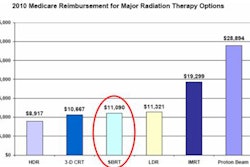An aggressive treatment combining intensity-modulated radiation therapy (IMRT) with chemotherapy has increased survival in patients diagnosed with anaplastic thyroid cancer. Most patients treated at the Mayo Clinic are living one to two years after treatment, versus the median outcome of death in five months.
Anaplastic thyroid cancer represents approximately 5% of the total new thyroid cancers diagnosed annually, which in the U.S. is estimated at 37,000 cases. Thyroid cancer has been on the rise, with the number of cases doubling in the past 10 years. It represents the 10th most frequently diagnosed cancer in the U.S. In some countries, thyroid cancer is the second most commonly diagnosed cancer in women after breast cancer.
Most common types of thyroid cancers respond well to timely treatment and have an excellent prognosis, with 95% of patients surviving. However, the diagnosis of anaplastic thyroid cancer is a death sentence. Keith Bible, MD, PhD, an associate professor of medical oncology at the Mayo Clinic in Rochester, MN, advises that median survival for patients is five months, based on published peer review literature of outcomes of approximately 1,700 patients. Only about 20% survive more than one year, regardless of therapy.
"The Mayo Clinic Cancer Center treats about five patients each year diagnosed with anaplastic thyroid cancer," Bible told AuntMinnie.com. "Only one in 10 patients survived more than one year after surgery and conventional radiation therapy. We wanted to do whatever could be done to change this. So starting in 2002, we changed our practice approach to replace conventional radiation therapy with a combined IMRT and aggressive chemotherapy treatment."
Robert Foote, MD, professor of radiation oncology, reported the results of 10 patients who were treated between 2003 and 2007 at the American Society of Clinical Oncology (ASCO) annual meeting in Chicago this month.
These 10 patients, among 24 who were newly diagnosed with anaplastic thyroid cancer during this time, elected to undertake IMRT combined with radiosensitizing and adjuvant chemotherapy in an effort to simultaneously control disease in the neck and forestall metastasis. The chemotherapy included four cycles of docetaxel 60 mg/m2 and doxorubicin 60 mg/m2 IV with pegylated filgrastim support.
No deaths resulted from this therapy; however, many of the patients required hospitalization due to side effects from the therapy, Bible reported. "Toxicity is a very real issue," he said.
Three patients died from their disease within 12 months following treatment, and one patient died within 24 months. However, six patients survived more than two years, five of them without evidence of disease. Two of the patients treated more than three years ago are still in remission.
"I think the real surprise for us with respect to this treatment protocol was that so many of our patients survived," Bible said. "We had limited expectations and were stunned and delighted to see the high survival rate."
A randomized trial combing two approaches to adding chemotherapy to radiotherapy will be launched at the Mayo Clinic Cancer Center in the fall and will also include other U.S. cancer treatment centers. Bible and Eric Sherman, MD, an oncologist specializing in head and neck cancers at Memorial Sloan-Kettering Cancer Center in New York City, will co-lead the study.
By Cynthia E. Keen
AuntMinnie.com staff writer
June 14, 2010
Related Reading
Radiation worsens thyroid cancer patient outcomes, April 20, 2009
Rising thyroid cancer rates in U.S. due to increased detection, May 10, 2006
Copyright © 2010 AuntMinnie.com



















